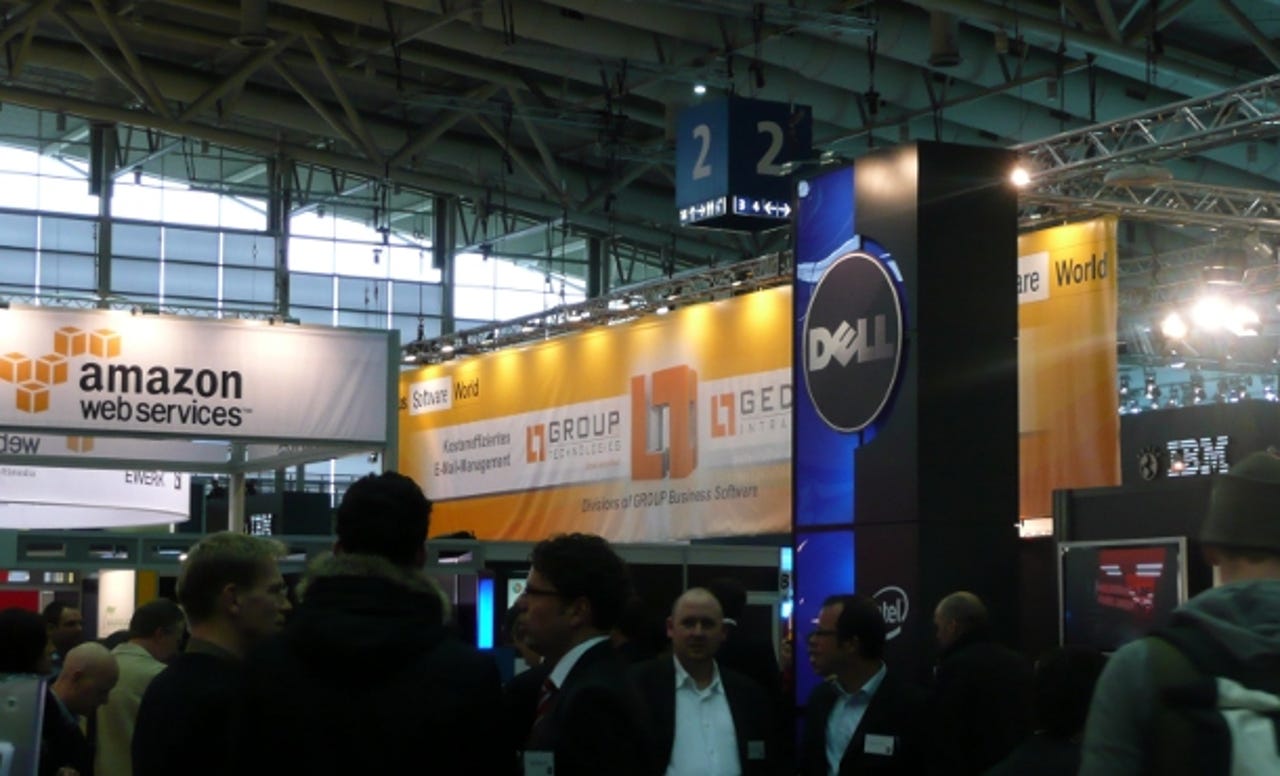iPhone apps, HTC Desire, nose biometrics and India's home of outsourcing


Photos of the month - March 2010
Last month saw the world's largest tech event kick off - the annual CeBIT trade show in Hannover, Germany - and silicon.com reporter Tim Ferguson was there to take a look.
Unsurprisingly tech's big names were out in force - Amazon, Dell and IBM all had stands, as shown above - and there was plenty of cool hardware making an appearance.
Check out the full story for a punter's eye view of CeBIT.
Photo credit: Tim Ferguson/silicon.com
Asus, best known for bringing the netbook to the mainstream with its Eee PC range, also had a huge stand at CeBIT.
Shown here is the new DR-900 Touch E-Reader, one of the many devices Asus unveiled at the event.
Click here to see more of the hardware Asus had on show.
Photo credit: Tim Ferguson/silicon.com
Meanwhile SAP used CeBIT to show off some of the projects that its research division is currently working on.
Its manufacturing demo incorporated a head-mounted display, shown above, which is worn by stock pickers in manufacturing facilities. German chancellor Angela Merkel even tried out the headset when she visited CeBIT on the first day.
See more of SAP's technology on show at CeBIT here.
Photo credit: Tim Ferguson/silicon.com
CeBIT's hangar-sized halls weren't the only massive tech installation that featured on silicon.com last month: this imposing building is NGD Europe.
The massive datacentre covers 75,000 square metres - the same size as Heathrow's Terminal 5 - and is capable of housing 19,000 racks of servers.
Located in Newport in Wales, the facility opened at the beginning of March.
Check out the full photo story to find out what makes such a big datacentre tick.
Photo credit: NGD Europe
Meanwhile on the streets of Bangalore, a vast transformation is underway as the Indian city becomes home to more and more IT outsourcing businesses and their workers.
The rush hour is one of Bangalore's major infrastructure challenges - and a possible hindrance to further growth. Traffic queues and horrendous pollution are common, and traffic policemen are often seen wearing surgical masks and ear muffs to protect themselves from the deafening noise and exhaust fumes.
For more pictures from silicon.com's columnist Sari Rai's photo tour of Bangalore last month, see the full story here.
Photo credit: Sari Rai/silicon.com
At the Intel Photonics Lab in California, researchers are pioneering new ways to transfer data at super fast rates using silicon germanium photodetectors.
silicon.com sister site CNET News.com went to take a look around the labs last month.
See how the chip giant is striving towards blisteringly fast data in the full photo story here.
Photo credit: James Martin/CNET
Fast data rates could come in handy for the Large Hadron Collider, the world's largest particle accelerator, which is expected to generate about 15 petabytes of data each year.
The LHC hit a new high last month when it recreated energies that existed a fraction of a second after the Big Bang.
The LHC, part of the Cern research institute in Geneva, Switzerland, is looking for evidence of the Higgs boson - a hypothetical particle that is thought to be responsible for giving mass to objects in the world around us.
Particle collisions will take place within the LHC for up to two years, allowing scientists to gather data for analysis.
Check out more from Cern and the LHC in the photo story here.
Photo credit: Cern
More interesting research came courtesy of the University of Bath, where scientists have carried out a study looking at how the scans of a person's nose could be used to verify their identity.
The researchers have been working on an experimental system that could help people prove they are who they say they are thanks to the distinct make-up of their nose.
Sniff out more pictures of this potentially fraud-busting tech here.
Photo credit: Adrian Moorhouse
Researchers at Cambridge University and Toshiba's R&D Lab in the city also had some exciting tech to show off this month - in the field of computer vision.
Roberto Cipolla, a professor of information engineering at the university and part-time MD of Toshiba's Cambridge R&D Lab, demonstrated a 3D modelling system capable of capturing the raw shape of the human face and body in real-time. Pictured above is the system's digital rendering of silicon.com reporter Natasha Lomas.
Click here to see more of the technology on show at Toshiba's R&D Lab.
Photo credit: Roberto Cipolla
Galileo, Europe's civilian-controlled global satellite navigation system, is on track to becoming operational by 2014.
Tech that will be able to make use of the Galileo system was shown off at the Galileo Application Day held at European Commission headquarters in Brussels last month.
The picture above shows a lawn mower that can navigate its way around the garden using satellite data from Galileo.
Check out the full story to see more innovative uses of Galileo.
Photo credit: Dippelhofer/Anwendungszentrum GmbH
Apps also made the headlines in March with silicon.com's round-up of the best apps to come out of the public sector, from an app that lets you check how many anti-social behaviour orders your neighbours have got, to one that lets you pilot a Royal Navy ship.
This Royal Navy app asks potential recruits to complete five games - each of which is "based on realistic Royal Navy training tasks".
In the game, the player assumes the role of the commander of a navy destroyer that urgently needs repairs.
Photo credit: Apple
Gordon Brown also jumped on the iPhone bandwagon last month, with the launch of a Number 10 app.
The free app brings together the Prime Minister's news and speeches as well as his YouTube videos and a picture gallery, seen here.
Click here to see what more the app can do.
Photo credit: Prime Minister's Office
One app still waiting for Apple's approval is the Opera Mini browser for iPhone, submitted to the Apple App Store last month.
Using server side rendering, Opera Mini compresses data by up to 90 per cent before sending it to the phone, according to Opera, meaning users can save the amount of data they consume while browsing the web.
For more, see the full photo story here.
Photo credit: Opera
As well as debuting the Opera Mini for iPhone last month, Opera also updated its desktop browser with a new interface.
Among the changes in Opera 10.50 are a redesign of the Ctrl+Tab hotkey which makes it easier to scroll through tabs by name (pictured above), with a single visual preview appearing of the highlighted tab.
See more of the revamped browser here.
Screenshot: Seth Rosenblatt/CNET
Along with Opera, Microsoft showed off some new software last month.
Office Communications Server 14 - the next version of Microsoft's business telephony, corporate instant messaging and presence server - is due out in the second half of the year.
OCS14 lets callers add a subject line to their phone call, so the receiver knows what the call is about before answering, shown in the picture above.
For more on OSC 14 see the full photo story here.
Photo credit: Microsoft
Microsoft recently unveiled its new Windows Phone 7 Series operating system and last month, the software giant had a few of the prototype Windows Phone 7 Series devices on display at its booth at the Mix10 conference in Las Vegas.
One of the demos on show at the conference was a version of Risk that ran using Bing Maps as the background.
For more photos of the prototype device, see the full story here.
Photo credit: Ina Fried/CNET
Also at Mix, Microsoft outlined how developers can write their own programs using Silverlight and XNA Game Studio.
Pictured above is a prototype Windows Phone version of the popular location-based Foursquare service.
See what else Microsoft has in store for developers here.
Photo credit: Microsoft
Another Microsoft protoype unveiled last month came in the form of OfficeTalk.
While OfficeTalk is currently a concept rather than a full product, Microsoft plans to road test it with a few customers.
A "company feed", seen in the picture above, lets workers easily discover what their co-workers are up to.
For more on OfficeTalk see the full photo story here.
Photo credit: Microsoft
Microsoft also showed off IE9 Platform Preview last month; headline features include support for web standards and faster performance.
This demonstration of whirling browser logos, pictured above, uses hardware acceleration to speed performance.
See the full photo story here.
Screenshot: Stephen Shankland/CNET
Another hotly anticipated piece of tech explored on silicon.com last month was the Desire, an Android-powered device from HTC.
The Desire sports HTC's new user interface, Sense, including its social aggregator feature, Friend Stream.
You can see more of the HTC Desire in action here.
Photo credit: HTC